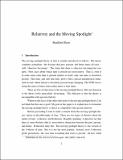Relativity and the Moving Spotlight
Author(s)
Skow, Bradford
Download6F021307d01.pdf (128.6Kb)
OPEN_ACCESS_POLICY
Open Access Policy
Creative Commons Attribution-Noncommercial-Share Alike
Terms of use
Metadata
Show full item recordAbstract
The moving spotlight theory of time is usually introduced as follows. The theory combines eternalism—the doctrine that past, present, and future times all exist— with “objective becoming.” The claim that there is objective becoming has two parts. First, facts about which time is present are non-relative. That is, even if in some sense each time is present relative to itself, only one time is absolutely present. That time, and only that time, glows with a special metaphysical status. And second, which instant is absolutely present keeps changing. The NOW moves along the series of times from earlier times to later times.
Date issued
2009-12Department
Massachusetts Institute of Technology. Department of Linguistics and PhilosophyJournal
Journal of Philosophy
Publisher
The Journal of Philosophy, Inc.
Citation
Bradford Skow, "Relativity and the Moving Spotlight," The Journal of Philosophy, 106 (December 2009): 666-678. © 2009 The Journal of Philosophy, Inc.
Version: Author's final manuscript
ISSN
0022-362X